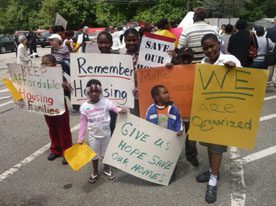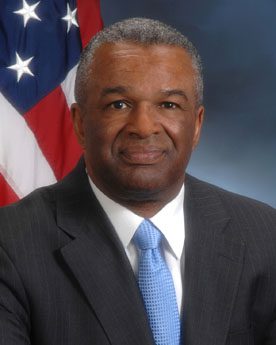No one has made a better case for the expansion of the Community Reinvestment Act (CRA) than the Federal Reserve Bank. Recently, the institution’s researchers discovered that of all the high-cost loans that led to the nation’s economic meltdown, less than 6 percent were made by CRA lenders in their assessment areas. In fact, the bank regulatory agency heads — Federal Reserve Chairman Ben Bernanke, Comptroller of the Currency John Dugan, and U.S. Federal Deposit Insurance Corporation Director Sheila Bair — have repeatedly reinforced the position that CRA had little or nothing to do with the bad loans that destroyed many neighborhoods.
Yet how does one reconcile that fact with the reality that the same low- and moderate-income (LMI) (and often predominately minority) CRA census tracts wound up with disproportionately greater numbers of these toxic loans?
The obvious answer is that the non-CRA regulated institutions targeted these areas. Quite true. But it is also true that CRA-regulated lenders were allowed to ignore and even abandon the LMI census tracts. Since 1989, there has been a systematic closing of bank branches in LMI neighborhoods, despite community groups’ efforts to keep some branches open.
In response, payday lenders, pawnshops, and check cashing services stepped into the void to provide basic banking services. Independent mortgage companies and high-cost mortgage lenders filled the vacuum created when the banks pulled out their mortgage lending business. The products offered were high cost, and sometimes predatory.
But if CRA, a federal law, affirmatively obligated banks to serve these communities, how were they able to close shop and ignore the credit needs of these neighborhoods’ residents? The answer, simply stated, is that the regulatory agencies charged with enforcing CRA failed to do their job.
After objecting to regulators about banks’ abandonment of LMI areas, NCRC was astounded to learn from the Federal Reserve Bank (FRB) that it did not see “bank branching” as covered by CRA because it “didn’t constitute a credit need.” Worse, although Congress empowered the FRB as early as 1994 to deal with toxic and abusive loans by providing the institution with the power to issue regulations against “unfair and deceptive” lenders, the FRB failed to act until July 2008. By that time, predatory lenders had long taken their toll on poorer neighborhoods — and eventually on the national economy.
There was a time when CRA led to tremendous growth. In the decade between 1989 and 1999, banks directed literally trillions of dollars in CRA loans and investments to low-wealth neighborhoods. Cal Bradford, formerly with National People’s Action, and Josh Silver of NCRC examined the written CRA commitments made by banks to community groups and their neighborhoods during this 11-year period, when lenders committed over $5 trillion to LMI areas. Community development corporations, community development financial institutions, and many other groups that had struggled to find grants, loans, and investments for their projects experienced an exponential growth during that time in their ability to provide affordable housing, economic development, and community development loans.
This success was attributable to the growth of community groups organizing around CRA, most notably NCRC, ACORN, National People’s Action (the organization that invented CRA), and the Greenlining Institute. The groups’ efforts were bolstered by President Bill Clinton, Hillary Clinton, and Comptroller Gene Ludwig, head of the national banking system — all of whom pushed for stronger CRA oversight and enforcement. At the same time, foundations like Heron, Mott, Ford, Surdna, Rockefeller, and MacArthur stepped in to fund and empower the groups’ activities.
The lesson? When active community groups are organizing around a CRA agenda that is leveraged by strong, deliberate bank regulatory oversight and enforcement, CRA works.
Two important opportunities that hold great promise for creating a more financially inclusive nation are now being debated in this Congress. The first, a bill to create a Consumer Financial Protection Agency (HR 3126), could increase regulatory oversight and enforcement of CRA and other critically important consumer laws. The second piece of legislation, the CRA Modernization Act of 2009 (HR 1479), strengthens CRA in several important areas. Most notably, it expands the number and type of financial institutions that would have an “affirmative obligation” to issue safe and sound loans to low- and moderate-income people.
But the success of both of these bills relies on their being reviewed during one of those “moments in time” when Congress decides to create good laws that genuinely benefit the public. Otherwise, they may be weakened beyond recognition or not passed at all. And the outcome is of immense importance to those who work to eradicate poverty in America.
The Consumer Financial Protection Agency
The most recent and significant opportunity to increase bank regulatory oversight and enforcement occurred on July 1, 2009, when President Obama proposed the creation of the Consumer Finance Protection Agency (CFPA). His concept was to take CRA and all of the existing fair lending and consumer protections away from the bank regulatory agencies and instead establish a consumer-focused agency to enforce these laws.
On July 9, 2009, Rep. Barney Frank, chairman of the House Financial Services Committee, offered HR 3126 to create the Consumer Financial Protection Agency. The bill is significantly weaker than the one offered by President Obama for a number of reasons.
First, Rep. Frank excluded CRA altogether from the proposed CFPA. Instead, he chose to leave the oversight of this critical law to the same regulators who had failed to enforce it for many years.
On Sept 20, 2009, in a memo to fellow members of Congress, Rep. Frank dealt three additional blows to the president’s original proposal. He amended HR 3126 by removing a product requirement that would have helped LMI and minority neighborhoods gain greater access to better products. He also removed the president’s “reasonableness” standard that would have required banks to guarantee that borrowers understood the products they were signing up for.
Finally, Rep. Frank changed the composition of the new oversight body from presidential appointees (consumers and citizens) to bank regulatory agencies. Under the House version of this bill, the oversight of the new “consumer” protection agency would revert to the Federal Reserve Bank, the OCC, OTS, NCUA, FDIC, FTC, and other government agencies — the same agencies whose lack of enforcement forced Congress to amend the consumer laws in the first place.
Finally, an additional amendment exempted nearly 8,000 of the eligible 8,200 from being examined by the CFPA.
Immediately after Rep. Frank announced these disappointing changes, community groups like NCRC and Americans for Financial Reform wrote to request that he return many of these provisions to the bill. But one group issued a press release on September 23, 2009, expressing its pleasure with these new changes: the American Bankers Association (ABA). The ABA continues to oppose the agency even in its weakened form; at the same time, it is pushing for more amendments, including one that would allow the agency to preempt state consumer protections — something that would be a disaster for LMI and minority neighborhoods.
But there is hope for a bill that more substantially helps all consumers, and in particular those living in LMI and minority neighborhoods. On November 10, Sen. Chris Dodd offered his own version of the Consumer Finance Protection Agency (within a broader bank reform bill) that restored all of the amendments that had been lost in Rep. Frank’s committee. Sen. Dodd’s CFPA language is nearly identical to that offered by President Obama, and community groups across the country are now mobilizing to support the initiative.
A law is only as good as the sheriff responsible for enforcing it. The CFPA creates a new sheriff with real authority, whose primary mission is to protect consumers. If Sen. Dodd’s and President Obama’s version of the CFPA passes, the opportunity for fair and equal access to quality credit and banking services would be dramatic.
The CFPA bill was eventually rolled up into a larger regulatory reform bill called Wall Street Reform and Consumer Protection Act (HR 4173). As Shelterforce goes to press, that bill is being debated, along with the over 250 amendments that have been attached to it. An ongoing concern is an amendment that would allow the agency to preempt existing state laws that currently protect consumers.
The CRA Modernization Act of 2009
There is more good news on the financial horizon. The long-awaited bill to expand and strengthen CRA was introduced on March 12, 2009 by way of the leadership of Rep. Eddie Bernice Johnson (D-Texas) and Rep. Luis Gutierrez (D-Ill.) who announced the CRA Modernization Act (HR 1479) at NCRC’s annual conference.
This bill makes several critical changes to the Community Reinvestment Act as it currently stands — all of which would dramatically increase lending, services and investments in LMI and minority neighborhoods.
The bill:
- Expands the number of financial institutions that would fall under CRA, including independent mortgage companies and mainstream credit unions;
- Closes loopholes that allowed banks’ subsidiaries to avoid being considered or covered for CRA purposes;
- Strengthens the CRA exam by creating more specific and defined grades;
- Requires that race be considered under CRA exams;
- Expands a bank’s CRA assessment areas to include regions where the bank does a significant amount of business, whether or not it has branches there;
- Enhances the small business data disclosure currently required of banks to include the amount of individual loans and the race and gender of the borrowers.
To date, 60 members of Congress have signed on to sponsor the bill. But its passage depends on the House Financial Services Committee and a decision by its chairman, Rep. Frank, to promote this bill or some revised version of it. Frank has said that he will not take this bill up now, and that it will have to wait until early 2010.
Rein in Lending Abuse
This Congress acted expeditiously to financially support the banking sector to prevent its collapse and further damage to our national economy. They now owe it to the American public to pass legislation that is going to rein in lending abuses, to protect consumers and expand financial access to fair and responsible loan products and services. As community advocates and organizers, we owe it to our constituents to not leave these improvements and opportunities for another day or another Congress.
Congress needs to understand that the public will support strong and decisive initiatives to end abusive lending practices, but the public will not stand for doing little or nothing to address the needs of blue-collar workers. Legislators should be concerned about the outrage of those who have seen their wealth eroded by abusive lending practices and watched their neighborhoods move from poverty to devastation. They should fear the segment of the middle class that is slipping into the ranks of the lower income, growing in numbers and becoming increasingly dissatisfied.
This is a critical moment for everyone concerned with financial justice in America, and the opportunities to address economic inequities and to promote financial inclusion have never been greater. The majority of the public is clear on this: banks and Wall Street have been helped, and it is now time to help consumers by establishing strong consumer protections and increased access to responsible lending. The question is whether politicians will exhibit the leadership and courage necessary to translate this moment in time into one of opportunity and promise. Will this Congress be known as the “faux Congress” that talks a lot, proposes a lot, but in the end passes only weak and minimally helpful bills, such as the recently passed credit card bill? Or will it pass a strong Consumer Financial Protection Agency Act and an enhanced Community Reinvestment Act that will pay dividends to consumers and the U.S. economy for years to come?
The battle shifts now to the U. S. Senate, and it is fair to say that whatever is accomplished on the House side of Congress forces the Senate to act and is therefore important and valuable. But we will all be looking to the leadership of Sen. Dodd, Sen. Harry Reid, and Sen. Dick Durbin to restore much of what was lost on the House side and to raise the bar on regulatory oversight and consumer protections.





Comments